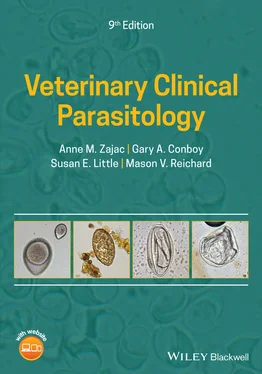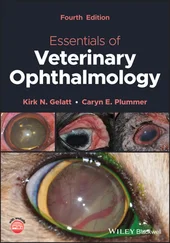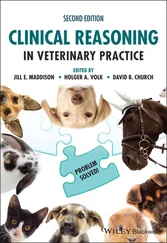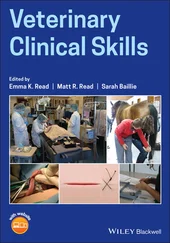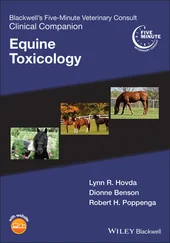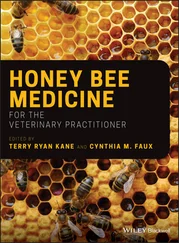cysts are yeast (
a ...Fig. 1.57
Giardia trophozoite in a direct saline smear. Trophozoites are bil...Fig. 1.58 Unstained
Giardia trophozoite in a direct saline smear. The concav...Fig. 1.59
Giardia trophozoite (
arrow ) associated with a portion of mucosa in...Fig. 1.60 Although
Ancylostoma is the most common genus of hookworm in the U...Fig. 1.61
Ancylostoma tubaeforme larvated and undeveloped eggs from a cat. T...Fig. 1.62 Egg of
Mammomonogamus from a cat. This egg is most likely to be se...Fig. 1.63
Toxocara eggs are typical ascarid eggs with a thick shell. They co...Fig. 1.64 When the microscope is focused on the surface of a
Toxocara egg, t...Fig. 1.65
Toxascaris leonina egg and
Toxocara cati eggs. Note the dark singl...Fig. 1.66
Baylisascaris procyonis egg in feces of a naturally infected dog. ...Fig. 1.67
Toxocara canis egg and
Baylisascaris procyonis egg (
arrow ). Eggs o...Fig. 1.68
Toxocara (Ta)
, Toxascaris (Ts) and
Baylisascaris (B) eggs in a can...Fig. 1.69
Toxocara and other ascarids typically require several weeks of dev...Fig. 1.70 Canine fecal sample containing
Toxocara canis (T) and
Ancylostoma ...Fig. 1.71
Toxocara ,
Ancylostoma , and
Trichuris eggs in a canine fecal sample...Fig. 1.72 Ascarids are often passed in the feces or vomitus of dogs and cats...Fig. 1.73 The morphology of the anterior end of small animal ascarids can be...Fig. 1.74 The cervical alae of adult
Toxocara canis (A) are similar in appea...Fig. 1.75 The egg of
Trichuris vulpis with its prominent bipolar plugs is on...Fig. 1.76 Feline fecal sample containing eggs of
Ancylostoma (A),
Mammomonog ...Fig. 1.77
Eucoleus eggs are passed in the undifferentiated one‐ or two‐celle...Fig. 1.78 The only canine parasite eggs that could be mistaken for whipworm ...Fig. 1.79 Portion of a
Trichuris vulpis egg (A) demonstrating the ridges see...Fig. 1.80 Examination of the surface of the shell wall of small‐animal capil...Fig. 1.81 In addition to having a morula that does not fill the interior of ...Fig. 1.82 Eggs of
Aonchotheca putorii are similar to those of other capillar...Fig. 1.83
Physaloptera eggs do not float consistently in routine flotation e...Fig. 1.84 Adult
Physaloptera may be seen with gastroscopy in cases where rou...Fig. 1.85
Spirocerca eggs do not float consistently in common flotation solu...Fig. 1.86
Strongyloides larvae must be differentiated from hatched hookworm ...Fig. 1.87 First‐stage larvae of
Strongyloides stercoralis have a well‐define...Fig. 1.88 Iodine‐stained
Strongyloides first‐stage larva. The prominent geni...Fig. 1.89 To confirm identification of
S. stercoralis , the fecal sample can ...Fig. 1.90
Aelurostrongylus larva in a feline fecal sample. Larvae have the d...Fig. 1.91 Detail of the tail of
Aelurostrongylus abstrusus larva showing its...Fig. 1.92 The tail of
Crenosoma larvae has a slight deflection but lacks a d...Fig. 1.93
Angiostrongylus vasorum first‐stage larva. This species is uncommo...Fig. 1.94 First‐stage
Oslerus larva in dog feces. The larvae have a kinked t...Fig. 1.95 First‐stage larva of
Filaroides hirthi , which is similar in appear...Fig. 1.96 Adult male
Ollulanus tricuspis in a fecal sample. Larvae and adult...Fig. 1.97
Dipylidium caninum eggs, each containing a hexacanth embryo, occur...Fig. 1.98 Occasionally,
Dipylidium eggs are released from the packets and ma...Fig. 1.99
Dipylidium caninum segments on the surface of a canine fecal sampl...Fig. 1.100
Taenia eggs are brown with a thick shell wall (embryophore) and c...Fig. 1.101 Eggs of
Eucoleus (E),
Toxocara (To), and
Taenia (Ta) and oocysts ...Fig. 1.102 Tapeworm segments from an animal (A) can usually be easily identi...Fig. 1.103 Embryonic hooks are visible in the two
Taenia or
Echinococcus egg...Fig. 1.104
Mesocestoides eggs have a thin, clear, smooth shell wall and cont...Fig. 1.105 Mature tapeworm segments passed in the feces may be observed by o...Fig. 1.106 Within hours of passing from the host, tapeworm segments lose the...Fig. 1.107 Unlike common tapeworms,
Diphyllobothrium eggs lack hooks and res...Fig. 1.108 The operculate eggs of
Spirometra also resemble trematode eggs. T...Fig. 1.109
Alaria eggs are large, operculate, yellow‐brown in color and cont...Fig. 1.110 Sometimes
Alaria spp. eggs are detected using the centrifugal flo...Fig. 1.111
Paragonimus eggs have an undifferentiated embryo when passed in t...Fig. 1.112 The operculated eggs of
Nanophyetus contain an undifferentiated e...Fig. 1.113 The large, elliptical eggs of
Heterobilharzia americana have a sm...Fig. 1.114 On contact with freshwater,
H. americana eggs hatch, releasing a ...Fig. 1.115 The small brown eggs of
Platynosomum have an operculum at one end...Fig. 1.116
Platynosomum (arrow) and
Trichuris eggs in the feces of a cat. Bo...Fig. 1.117
Cryptocotyle lingua egg detected on fecal sedimentation of feces ...Fig. 1.118
Metorchis is another genus of flukes present in wild animals that...Fig. 1.119 Large eggs of
Linguatula may be seen in dogs in North America wit...Fig. 1.120
Macracanthorhynchus ingens eggs. Acanthocephalan eggs contain a l...Fig. 1.121 Parasites found in bovine feces.Fig. 1.122 Parasites found in feces of sheep and goats.Fig. 1.123 Ruminants and camelids are infected with a variety of
Eimeria spp...Fig. 1.124 Bovine
Eimeria oocysts (relative sizes not accurate; see Table 1....Fig. 1.125 Small ruminants are infected with a variety of coccidia species, ...Fig. 1.126 The oocyst shown here is
E. ninakohlyakimovae from a goat. A simi...Fig. 1.127 Many, but not all,
Eimeria species have a cap that covers the mic...Fig. 1.128 In this bovine fecal sample, several fully sporulated
Eimeria ooc...Fig. 1.129
Eimeria llamae (A) and the smaller
E. punonensis (B) are coccidia...Fig. 1.130 New World camelids are also infected with two species of
Eimeria ...Fig. 1.131 The small oocysts of
Cryptosporidium are best seen using the high...Fig. 1.132
Cryptosporidium oocysts can also be detected in acid fast‐stained...Fig. 1.133 This calf fecal sample contains a larvated
Strongyloides egg (S) ...Fig. 1.134 Cyst of
Buxtonella sulcata . These cysts may be seen in bovine fec...Fig. 1.135 The strongylid (also referred to as strongyle or trichostrongyle)...Fig. 1.136 Once strongylid eggs are exposed to oxygen and adequate temperatu...Fig. 1.137 Egg of
Nematodirus sp. This is one of the few strongylid eggs of ...Fig. 1.138 Ovine fecal sample containing strongylid eggs (S), and a
Nematodi ...Fig. 1.139
Strongyloides eggs may be confused with strongylid eggs. The two ...Fig. 1.140
Trichuris eggs are common in ruminant feces. They have a thick, b...Fig. 1.141 This bipolar
Aonchotheca (
Capillaria ) egg can be confused with
Tr ...Fig. 1.142 Ruminant fecal sample containing both
Trichuris (T) and
Aonchothe ...Fig. 1.143 Camelids can be infected with
Aonchotheca sp. but are also parasi...Fig. 1.144
Toxocara vitulorum eggs have the thick shell typical of ascarids....Fig. 1.145
Skrjabinema (Sk), the ruminant pinworm. Pinworm eggs often appear...Fig. 1.146 Iodine‐stained
Muellerius larva.Fig. 1.147
Muellerius larvae can be easily identified by the presence of a k...Fig. 1.148
Читать дальше
